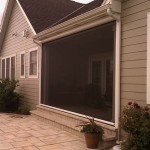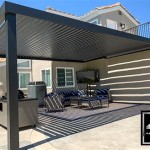Patio Furniture Ideas for Decks: Enhancing Outdoor Living Spaces
Transforming a deck into a comfortable and stylish outdoor living space requires careful consideration of patio furniture. The selection process involves balancing aesthetics, functionality, durability, and the available space. With numerous options available, understanding the nuances of different furniture types and their suitability for various deck designs is crucial.
The purpose of the deck dictates the type of patio furniture most appropriate. A deck primarily used for dining necessitates a sturdy table and comfortable seating. Conversely, a relaxation-oriented deck may benefit from lounge chairs, sofas, and coffee tables. Consideration also needs to be given to the deck’s size and shape to prevent overcrowding and ensure easy movement.
Material Selection: Durability and Aesthetics
The material from which patio furniture is constructed significantly impacts its longevity and aesthetic appeal. Common materials include wood, metal, plastic, and wicker, each possessing distinct advantages and disadvantages.
Wood furniture offers a classic and natural look. Teak, cedar, and redwood are popular choices due to their inherent resistance to moisture and insects. However, wood furniture requires regular maintenance, such as staining or sealing, to prevent weathering and decay. Different wood types require different levels and types of treatment with teak requiring the least and softer woods like cedar and redwood requiring more upkeep.
Metal furniture, particularly aluminum, is lightweight, durable, and rust-resistant, making it suitable for various climates. Wrought iron provides a more ornate and heavier option, offering stability in windy conditions. However, wrought iron requires regular painting to prevent rust. Aluminum furniture is often powder-coated and while this extends its life, it can be scratched and worn down over time requiring eventual re-coating for extensive longevity.
Plastic and resin furniture are affordable, low-maintenance, and available in a wide range of colors and styles. High-density polyethylene (HDPE) is a durable and weather-resistant option that mimics the appearance of wood. While plastic is easy to clean and typically resists most stains, it is not as aesthetically pleasing as wood or metal, and it can fade or become brittle with prolonged exposure to sunlight. The lower price point often makes it a worthwhile choice given its long-term durability and ease of maintenance.
Wicker furniture, traditionally made from natural materials like rattan, offers a lightweight and stylish option. Synthetic wicker, crafted from resin, provides enhanced durability and weather resistance. Wicker furniture is comfortable and adds a touch of elegance to any deck. However, natural wicker requires protection from moisture, while synthetic wicker is more suitable for outdoor use. In both cases, cushions are generally required for comfort, and these cushions require cleaning and storage during inclement weather.
Arrangement and Space Optimization
Effective arrangement of patio furniture is crucial for maximizing the usability and visual appeal of a deck. The layout should facilitate conversation, relaxation, and movement.
For smaller decks, modular furniture offers versatility and space-saving solutions. These sets can be arranged in various configurations to suit different needs. Folding furniture is another practical option, allowing for easy storage when not in use. Benches with built-in storage provide additional seating and storage space for cushions, blankets, or other outdoor essentials. Using multilevel design with raised planters or small vertical gardens can add depth and dimension to a smaller deck.
Larger decks provide more flexibility in furniture arrangement. Creating distinct zones for dining, lounging, and socializing enhances the functionality of the space. A dining area with a table and chairs can be complemented by a separate seating area with sofas, armchairs, and a coffee table. Incorporating an outdoor rug can define the seating area and add warmth and texture. A fire pit or outdoor fireplace can serve as a focal point and extend the usability of the deck into cooler months.
When arranging furniture, consider the flow of traffic. Ensure that there is ample space for people to move freely between different areas of the deck. Avoid blocking pathways or creating bottlenecks. Strategically placed plants and lighting can further enhance the ambiance and functionality of the space. These elements should be chosen and arranged to complement the furniture and create a cohesive and inviting outdoor environment.
The orientation of the deck relative to the sun is another critical factor. If the deck receives direct sunlight throughout the day, consider incorporating shade elements such as umbrellas, pergolas, or awnings. Strategically positioned trees or shrubs can also provide natural shade. Conversely, if the deck is shaded, choosing lighter-colored furniture and incorporating reflective surfaces can brighten the space.
Style and Aesthetics: Complementing Deck Design
The style of patio furniture should complement the overall design of the deck and the surrounding landscape. Harmonizing the furniture with the architectural style of the house creates a cohesive and aesthetically pleasing outdoor space.
For modern decks, sleek and minimalist furniture with clean lines and neutral colors is often a good choice. Metal and concrete furniture, along with geometric shapes, can enhance the contemporary aesthetic. Incorporating pops of color through cushions, pillows, or accessories can add visual interest. Outdoor lighting with clean designs that complement the furniture style should also be selected. Contemporary style emphasizes simplicity and functionality, prioritizing clean lines and a streamlined appearance.
Traditional decks benefit from classic and timeless furniture designs. Wicker, wood, and wrought iron furniture with ornate details can create a warm and inviting atmosphere. Earth tones, floral patterns, and natural textures complement the traditional style. Traditional outdoor spaces often incorporate flower beds, traditional garden art, and classic design elements, which the furniture should complement to create a cohesive design. The main objective of this style is to create a warm, welcoming space.
Rustic decks can be enhanced with furniture made from natural materials such as reclaimed wood, stone, and metal. Simple, sturdy designs and earthy colors contribute to the rustic aesthetic. Incorporating elements such as tree stumps, wooden benches, and handmade accessories adds character and charm. Rustic design often includes natural elements and aims to blend with the surrounding landscape, creating a sense of harmony with nature.
Coastal-themed decks call for light and airy furniture made from materials such as wicker, rattan, and light-colored wood. Nautical stripes, seashells, and ocean-inspired accessories can enhance the coastal vibe. Incorporating blue, white, and sandy hues creates a relaxing and breezy atmosphere. Coastal style furniture is often designed to withstand the elements and evoke a sense of relaxation and ease, similar to a beachside setting.
Accessories play a crucial role in enhancing the style and ambiance of a deck. Outdoor rugs define seating areas, while cushions and pillows add comfort and color. Planters filled with flowers, herbs, or greenery bring life and vibrancy to the space. Outdoor lighting, such as string lights, lanterns, or spotlights, creates a warm and inviting atmosphere in the evening. The choice of accessories should complement the furniture and overall design of the deck.
Ultimately, choosing the right patio furniture for a deck involves carefully considering the materials, arrangement, and style. By balancing these factors, homeowners can create an outdoor living space that is both functional and aesthetically pleasing. The furniture should enhance the deck's usability and complement the surrounding landscape, creating a comfortable and inviting environment for relaxation, dining, and socializing. Careful planning and thoughtful selection are key to transforming a deck into a valuable extension of the home.
Beyond the basic furniture elements, consider adding personal touches that reflect individual tastes and preferences. This might include artwork, sculptures, or unique decorative items that add personality and character to the space. These elements can transform a generic deck into a unique and personalized outdoor retreat. The goal is to create a space that is not only functional but also reflects the homeowner's individual style and creates a welcoming environment for guests.
Maintenance is also an important consideration. Regular cleaning and upkeep will ensure that the patio furniture remains in good condition for years to come. Different materials require different levels of maintenance. Wood furniture needs to be stained or sealed regularly, while metal furniture may need to be painted to prevent rust. Plastic and resin furniture can be easily cleaned with soap and water. Cushions and pillows should be cleaned regularly and stored indoors during inclement weather. By taking care of the patio furniture, homeowners can enjoy their outdoor living space for many years to come.
:strip_icc()/100092481-ca052c16890440868979ff49832f94b9.jpg?strip=all)
16 Patio Furniture Ideas To Make Your Backyard A Destination

14 Cozy Small Deck Decorating Ideas To Impress Timbertech

Outdoor Furniture Arrangement Ideas Thriftydecorchick Patio Layout Deck

9 Best Outdoor Deck Furniture Design Ideas Decks Com

9 Best Outdoor Deck Furniture Design Ideas Decks Com

Decks Outdoor Patio Furniture Design Ideas Traditional Deck Columbus By Lily Ann Cabinets Houzz
:strip_icc()/outdoor-furniture-ideas14-47020e88e2334f9dab483123c291c9c9.jpg?strip=all)
13 Deck Furniture Ideas For A Dream Backyard

15 Deck Furniture Ideas Design Inspiration Timbertech

Fun And Functional Outdoor Furniture Ideas Forbes Home

Deck Decorating Ideas Stunning Decor Inspo Worthing Court








